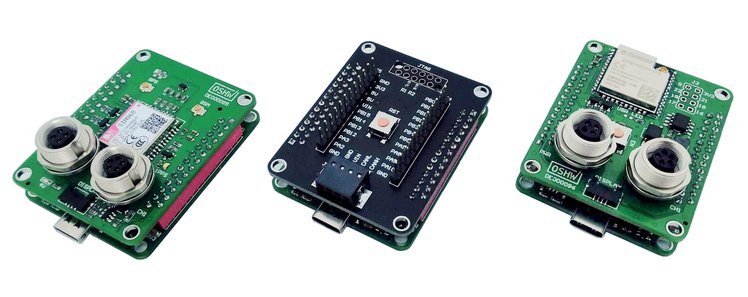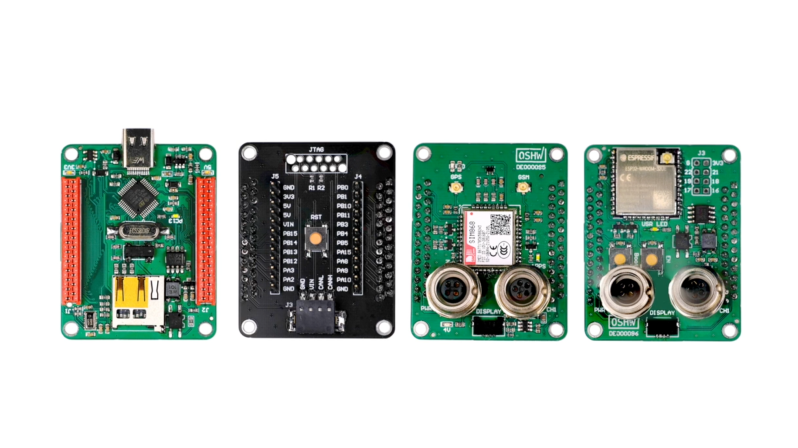[Florian] and his engineering team at Munich-based bmc::labs has developed a clever set of prototyping boards for vehicle hacking and rapid product development, collectively called the bmc::board or bmc::mini. These stackable development boards were initially designed for in-house use. The team took a general purpose approach to the design so the boards could be used across a wide range of projects, and they should be useful to anyone in the field. [Florian] decided to release the boards to the community as open-source and certified by OSHWA (Open Source Hardware Association).
There are four boards currently defined, with several more in the works:
- mini::base — Main microcontroller board, STM32F103-based
- mini::out — I/O board with CAN bus, JTAG, etc.
- mini:: grid — RF board providing GPS and GSM capability
- mini::pit — local wireless connectivity, WiFi and Bluetooth, and 2nd CAN bus

At 54 x 42.5 mm, these boards are pretty small; a form-factor they describe as “exactly half a credit card”. We like the Wurth WR-MM family of stacking connectors they are using, and the symmetrical pinout means you can rotate the cards as needed. But at first glance, these thru-hole connectors seem to limit the stack to just two boards, although maybe they plan move to an SMT flavor of the connector in future designs permitting taller stacks.
If you’re into vehicle electronics and/or vehicle hacking, definitely take a look at these. You can check out [Florian]’s bmc::board Hackaday.io project page and the team’s GitHub repository for more details. Here’s another project by team member [Sebastian] using one of the future bmc::bike modules to eavesdrop on ECU communications, where he sensibly advises the reader “First, pull over and get off the bike. Never hack a two-wheeled vehicle while riding it!”.
No discussion of vehicle CAN bus tools should omit the work of Craig Smith, who literally wrote the book on hacking your car, and whose talk along with Hackaday’s own Eric Evenchick of CANtact fame we covered back in 2016. [Florian] has started a CrowdSupply campaign where you can see some more details of this project and a short promotional video.
















Using a STM32F103 in a new design feels like powering a 3D printer with an ATMEGA328P.
I don´t understand why a compatible, more powerful, equally available and barely more expensive STM32F411 was not used, in regards to the whole BOM cost.
The STM32F411 goes down to 10uA in sleep mode, has an FPU, better peripherals… why NOT ?
This!!
because 103 is the cheapest from china, in case scaling.
This argument does not hold for such a low volume production with that expensive BOM and fancy connectors.
I don’t think it was a bad design decision – the F103 is very low cost. My guess is even that lowly 328P could handle most of the tasks. The base board could be updated to a newer processor (F401, F411 or F7xx series) pretty easily – if this takes off, that would probably happen very quickly.
Unfortunately, STM32 chips are all in very short supply these days with 6 month or longer lead times.
Okay, I followed the rabbit hole a bit there. Is there any (example) software for this platform? The example appears to be blinking the LED.
Which is great, don’t get me wrong, but unless it’s blinking an LED via CAN I don’t find it terribly interesting as a coding example.
Could be I’m just not making with the clickey-clickey in the right spot.
Well, the rabbit hole is deeper than you think.
Anything that runs on a STM32F103 runs here. There are tons of example. YES, you might need to check your includes and declare other pins for your peripherals than in the examples you found, but basically, you can use STM32Cube, CMSIS, Arduino, mbed, FReeRTOS …
Great!
My daughter just got her Driver’s License!
“We like the Wurth WR-MM family of stacking connectors they are using,”
So, without them these boards are Wurth-less?
B^)